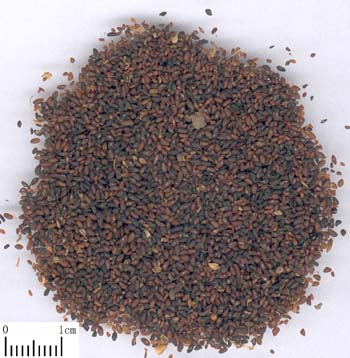车前子
Naming
Che Qian Zi (Semen Plantaginis)——Shen Nong Ben Cao Jing (Shen Nong’s Herbal)
Origin
The mature seed of the perennial herbaceous plant Plantago asiatica L. or P. depressa Willd. of family Aginaceae.
Location
In all parts of China.
Harvest
Collected in summer and autumn when the seed is ripe.
The true smell and taste
Slight in smell, bland in taste.
Best quality
Large, black and plump.
Processing
Unprocessed or parched with salt water.
Property
Sweet, slightly cold; kidney, bladder, liver and lung meridians entered.
Actions
Induce diuresis to relieve stranguria, drain dampness to check diarrhea, clear liver-fire to improve vision and clear lung heat and resolve phlegm.
Indications
A. Stranguria and edema
It is sweet and cold in property, so it has good actions of regulating water passages and clearing retained heat in bladder. It is especially suitable for heat stranguria due to down-pour of damp-heat in bladder manifested as dribbling, difficult and painful urination. It is usually combined with heat-clearing and dampness-draining herbs to reinforce the actions of inducing diuresis and relieving stranguria. For instance, it is combined with Mu Tong, Hua Shi and Qu Mai in the Ba Zheng San from Tai Ping Hui Min He Ji Ju Fang. It is also indicated for blood stranguria, urolithic stranguria and chylous stranguria by combining with relative herbs. For edema and dysuria due to water-damp retention, it is combined with edema-alleviating diuretics, such as Zhu Ling, Fu Ling, and Ze Xie, etc. For edema due to spleen deficiency or spleen-kidney deficiency, it is usually combined with spleen-invigorating and kidney-tonifying herbs. For instance, it is combined with Shu Di Huang, Shan Zhu Yu and Rou Gui, etc. in Shen Qi Wan from Ji Sheng Fang to treat kidney deficiency caused by chronic diseases manifested as heaviness of lumbus and edema of feet.
B. Diarrhea
It can induce diuresis and drain dampness, and treat diarrhea by inducing diuresis to make defecation forming. It is suitable for watery diarrhea due to excessive dampness. It can be used alone or ground into powder and taken with rice water. For diarrhea due to spleen deficiency and excessive dampness, it should be combined with spleen-invigorating, dampness-draining and diarrhea-checking herbs, such as Bai Zhu, Fu Ling, and Yi Yi Ren, etc. For diarrhea due to summer-heat and dampness, it is combined with damp-resolving and damp-draining herbs, such as Xiang Ru, Fu Ling, and Zhu Ling, etc. in Che Qian Zi San from Yang Shi Jia Cang Fang.
C. Blood-shot eye with swelling and pain, dim vision
It can clear liver-heat to improve vision. It is suitable for blood-shot eye with swelling and pain due to liver heat, and usually combined with liver-heat clearing herbs, such as Ju Hua, Jue Ming Zi, etc. For yin deficiency of liver and kidney manifested as dim vision, it is combined with kidney-liver-tonifying herbs. For instance, it is combined with Shu Di Huang, and Tu Si Zi, etc. in Zhu Jing Wan from Sheng Hui Fang ( Holy Benevolent Prescription).
D. Cough due to phlegm-heat
It has the actions of clearing lung-heat and resolving phlegm to relieve cough. It is suitable for cough due to lung heat manifested as profuse yellow and sticky phlegm, and is combined with lung-heat-clearing, phlegm-resolving and cough-relieving herbs such as Gua Lou, Zhe Bei Mu and Pi Pa Ye, etc.
Dosage and Administrations
Decoct 9~15g. It should be decocted with wrapping.

